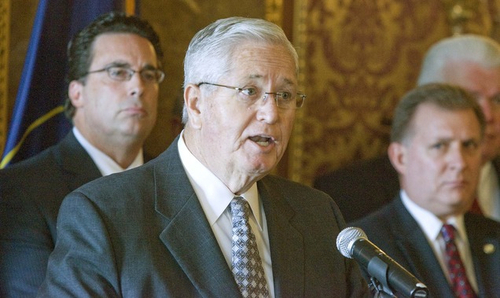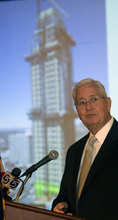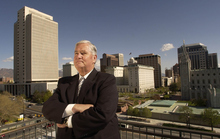This is an archived article that was published on sltrib.com in 2012, and information in the article may be outdated. It is provided only for personal research purposes and may not be reprinted.
H. David Burton, longtime presiding bishop of the LDS Church and the genial public face of the faith's decadelong effort to build a mammoth urban community of residences, offices and shops in downtown Salt Lake City, was released Saturday from the ecclesiastical post he has held since 1996.
The announcement — by Dieter F. Uchtdorf, second counselor in the faith's governing First Presidency, during the 182nd Annual General Conference — came just nine days after the church and Taubman Centers Inc. opened the retail component of City Creek Center, across the street from Temple Square and LDS Church headquarters.
Jason Mathis, executive director of the Downtown Alliance, said Burton "changed the fabric of downtown in very meaningful and beneficial ways," but also helped people in less public ways.
"He has a long history of working with multiple groups, organizations, people for the betterment of our entire community," Mathis said, "and we wish him well in his future endeavors."
The five years of City Creek construction began with the demolition of the old KeyBank tower and the Crossroads and ZCMI malls. It was a project that Burton, 73, helped guide since it was announced in 2003.
At 700,000 square feet, City Creek is special for several reasons. Burton and his secular counterpart William Taubman developed the megamall at a time when retail projects of that size aren't often constructed anymore.
What's more, the project, estimated to cost up to $2 billion, was bankrolled by the development arm of the Utah-based Church of Jesus Christ of Latter-day Saints, which did not use outside financing or draw on tithes made by its worldwide membership. Finally, the massive project provided close to 2,000 construction jobs at a time when the economy was in a deep recession.
Burton's counselors, Richard C. Edgley and Keith B. McMullin, also were released from the Presiding Bishopric. All three were made emeritus general authorities.
Burton was replaced by Gary E. Stevenson, 56, who grew up in northern Utah's Cache Valley and was serving as a member of the First Quorum of the Seventy and as president of the Asia North Area.
Stevenson will be assisted by Gérald Caussé, first counselor, and Dean M. Davies, second counselor. Caussé, 48, was a member of the First Quorum of the Seventy and a counselor in the Europe Area Presidency. Davies, 60, was employed by the church as managing director of the Special Projects Department.
While Burton may be best remembered for his efforts over more than a decade to shepherd City Creek in to life, he first came to wide notice in the clash over the church's Main Street Plaza, which closed Main Street between North Temple and South Temple. Court fights ensued. Community schisms appeared. Finally, in a controversial land-for-peace compromise, Salt Lake City, led by then-Mayor Rocky Anderson, gave up an easement on the plaza, allowing the LDS Church to control speech and behavior there, in exchange for cash and a community center in the west-side Glendale area.
Burton, who was born in Salt Lake City, differed with Anderson over a Main Street sky bridge linking City Creek's east and west retail components. Anderson disparaged it as a "gerbil tube." Approval of the elevated walkway came after Anderson's second term ended and Mayor Ralph Becker took the city's reins.
Anderson worked eight years with Burton and came to view him as a friend — despite their differences.
"When you look back over that many years of public service, the sharpest memories are of the quality of the people you work with," Anderson said. "My experience was enriched because of the excellent relationship that Bishop Burton and I had."
As presiding bishop, Burton and his counselors were in charge of the church's land, buildings and commercial businesses.
But though an economics degree from the University of Utah and his master's degree in business administration from the University of Michigan prepared him for a business-focused career, Burton has said that his most satisfying moments were working with humanitarian groups in Utah and around the world.
Within a day of Haiti's devastating earthquake in 2010, LDS officials in Salt Lake City mobilized the church's extensive resources to help with disaster relief. Burton led the effort.
"Whether it's with The Road Home here in Salt Lake City to provide transitional housing or shelter for the homeless or with the Red Cross and the Red Crescent in Africa to provide measles vaccinations, we are anxious to collaborate in unprecedented partnerships to help people, to alleviate suffering and to give individuals and communities the wherewithal to help themselves," Burton said last year upon receiving the Salt Lake Chamber's Giant in Our City award.
Burton came to the post of presiding bishop at age 57. He had served as a counselor in the Presiding Bishopric since 1992. Before then, he worked as its executive secretary and spent a year as the assistant church budget officer. He also worked for Kennecott Copper and the Utah Tax Commission.
In his 16 years as presiding bishop, Burton oversaw the building of 88 temples around the world (another 30 are announced or under construction), the LDS Conference Center and Church History Library, as well as the City Creek project.
He pushed the church to construct "green" meetinghouses.
"There is something very doctrinally sound when we talk about conservation of resources," Burton said in 2010 while touting an eco-friendly stake center in Farmington that boasts solar panels, xeriscaped landscaping and designated parking for electric cars. "This is a teaching moment. This aspect of our culture has become a vital part of our DNA."
A Burton associate said at the time that future LDS meetinghouses would spring from five prototypes developed that year.
In March 2011, Burton attended the signing ceremony for four immigration bills passed by the Utah Legislature.
The LDS Church had endorsed the so-called Utah Compact and its principles of immigration reform, including the need for a federal solution and keeping families together while enforcing the law and acknowledging the economic impact of immigrants.
Burton spearheaded the church's efforts to keep Nordstrom Inc. from leaving downtown and moving farther west to The Gateway shopping district. The retail giant ultimately decided to stay downtown and become a prominent part of City Creek.
"Bishop Burton is remarkable in his ability to bring an entire community together," said Lane Beattie, CEO of the Salt Lake Chamber. "His leadership in a time of unprecedented challenge has benefited Utahns of all faiths and people across the world."
When Burton was called as presiding bishop in December 1995, he went home to tell his wife.
"We both cried," he recalled in 1997. "We knew it would change our lives."
And Burton changed the face of downtown Salt Lake City.
Twitter: @sltribpaul —
The new LDS Presiding Bishopric
Presiding bishop • Gary E. Stevenson, 56, was a member of the First Quorum of the Seventy and president of the Asia North Area.
He earned an undergraduate degree in business administration from Utah State University. He co-founded Icon Health & Fitness Inc., where he served as president and chief operating officer until 2008.
Sevenson was raised in the Cache Valley. He is married to Lesa Jean Higley. They are the parents of four sons.
First counselor • Gérald Caussé, 48, was serving as a member of the First Quorum of the Seventy and as a counselor in the Europe Area Presidency.
Caussé received a master's degree in business from ESSEC. His career has been in the food industry, where he has worked with several supermarket chains and food-distribution companies in Europe.
Caussé was born in Bordeaux, France. He is married to Valérie Lucienne Babin. They have five children and one grandson.
Second counselor • Dean M. Davies, 60, was employed by the LDS Church as the managing director of the Special Projects Department with responsibility for special purpose real estate, temple design and temple construction.
Davies has a degree in agricultural economics from Brigham Young University and has completed advanced executive programs at Stanford and Northwestern universities.
He was born in Salt Lake City and is married to Darla James. They have five children and 14 grandchildren.
Source: LDS Church







